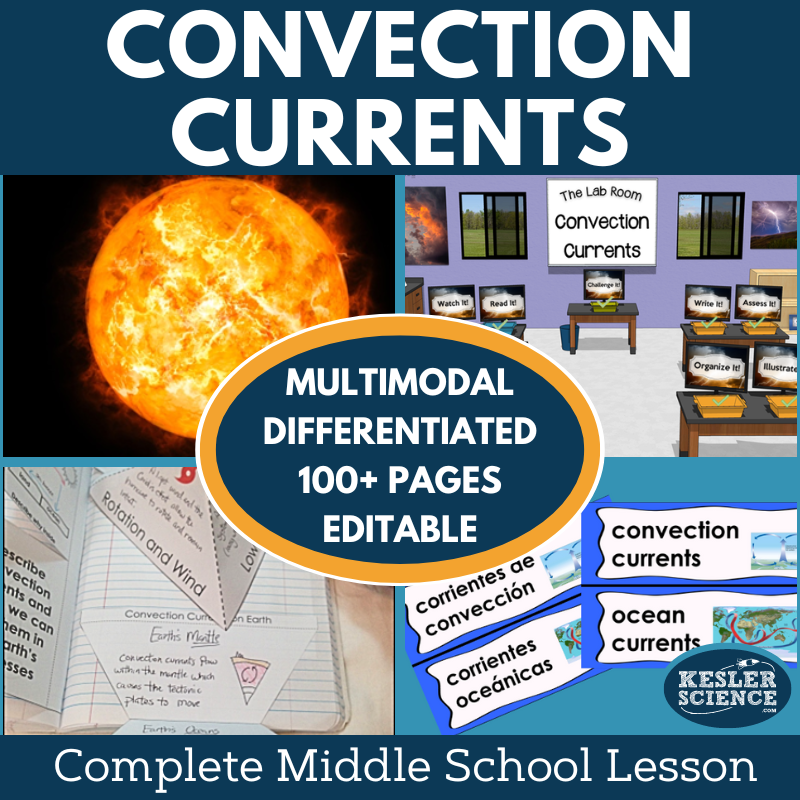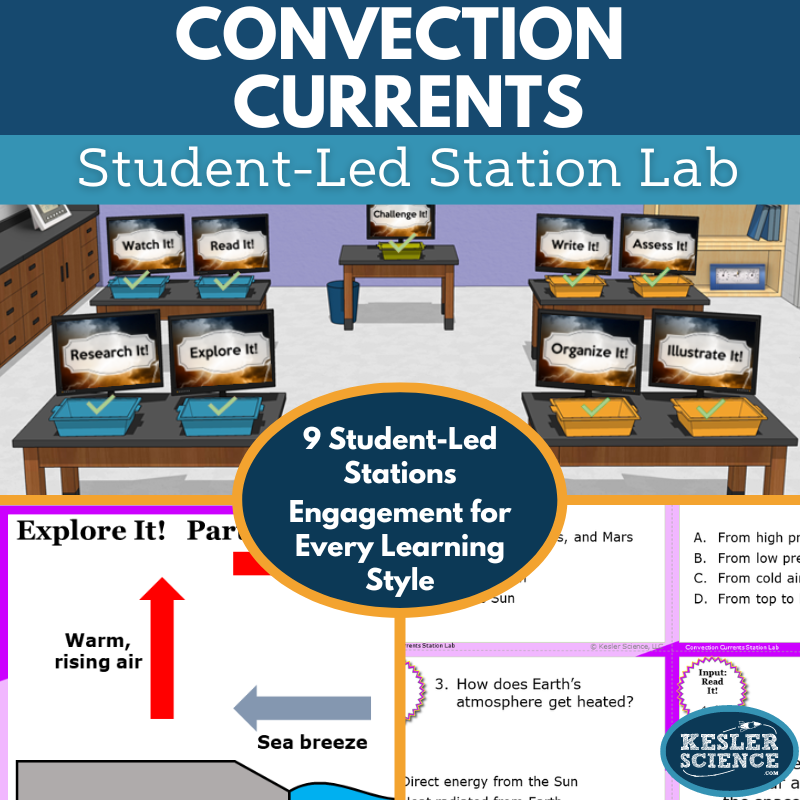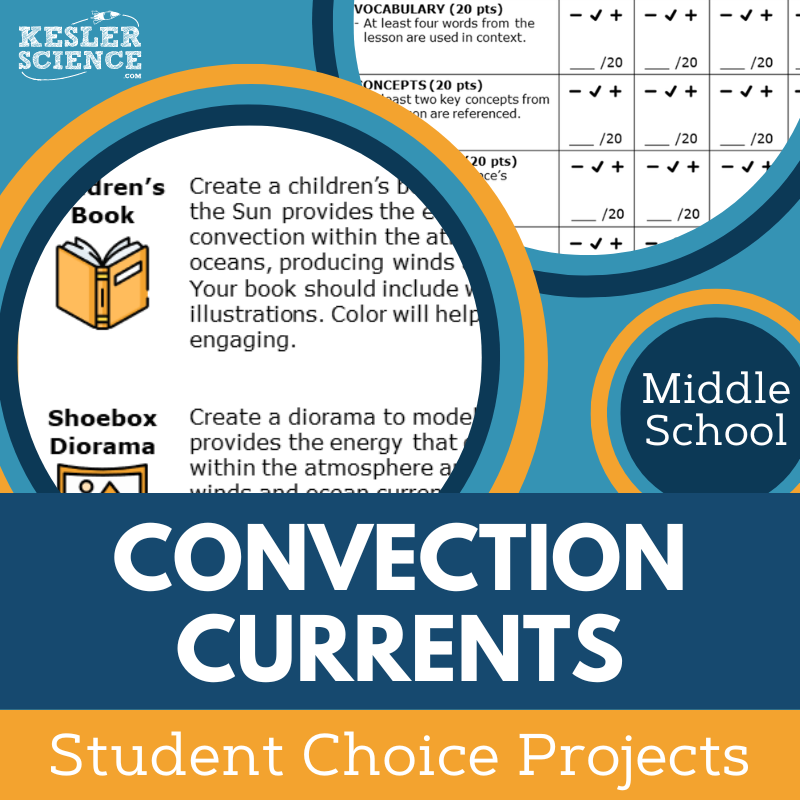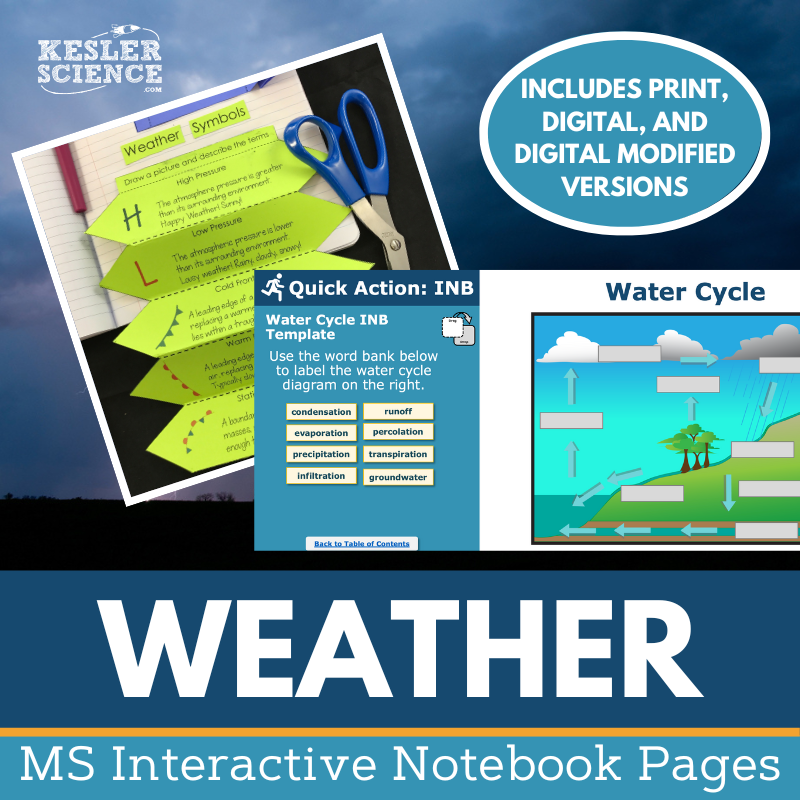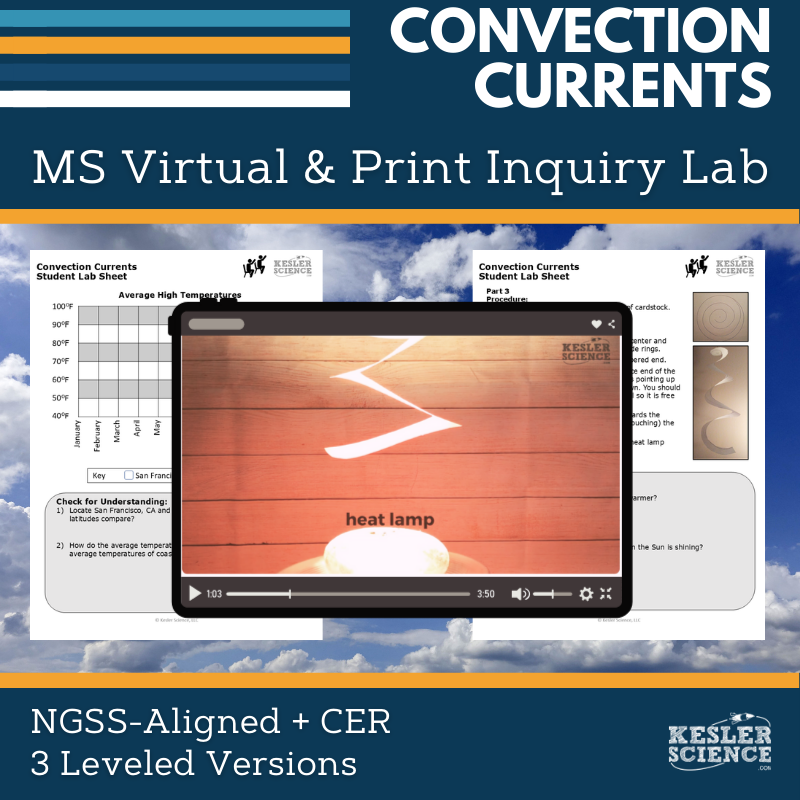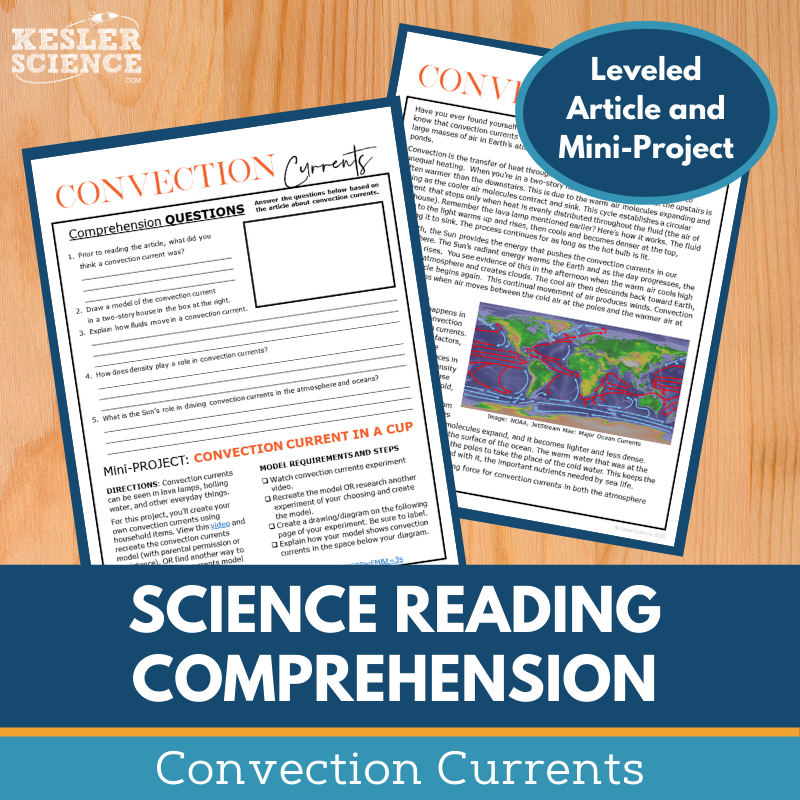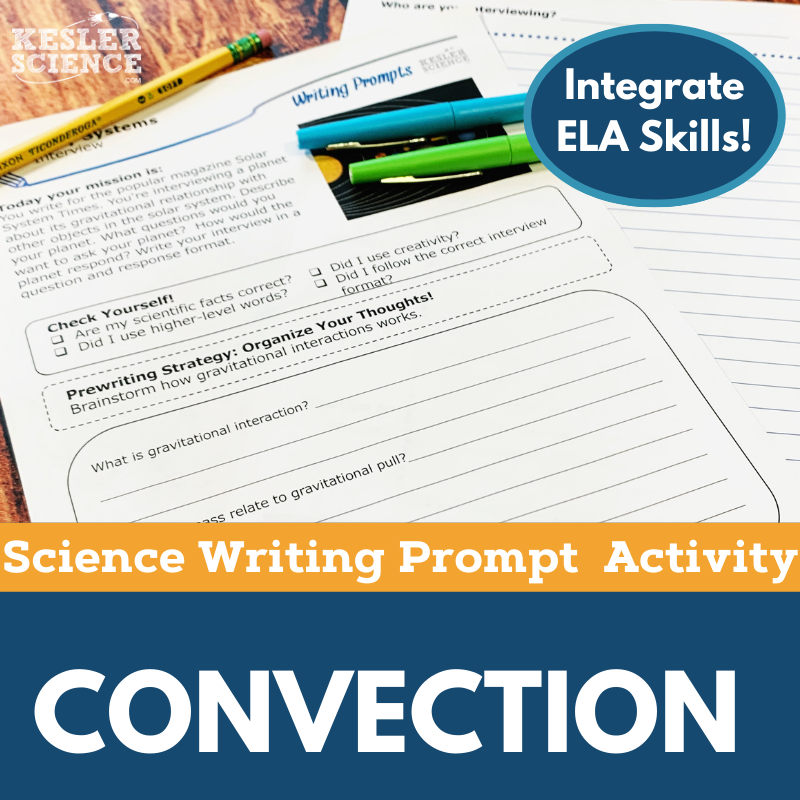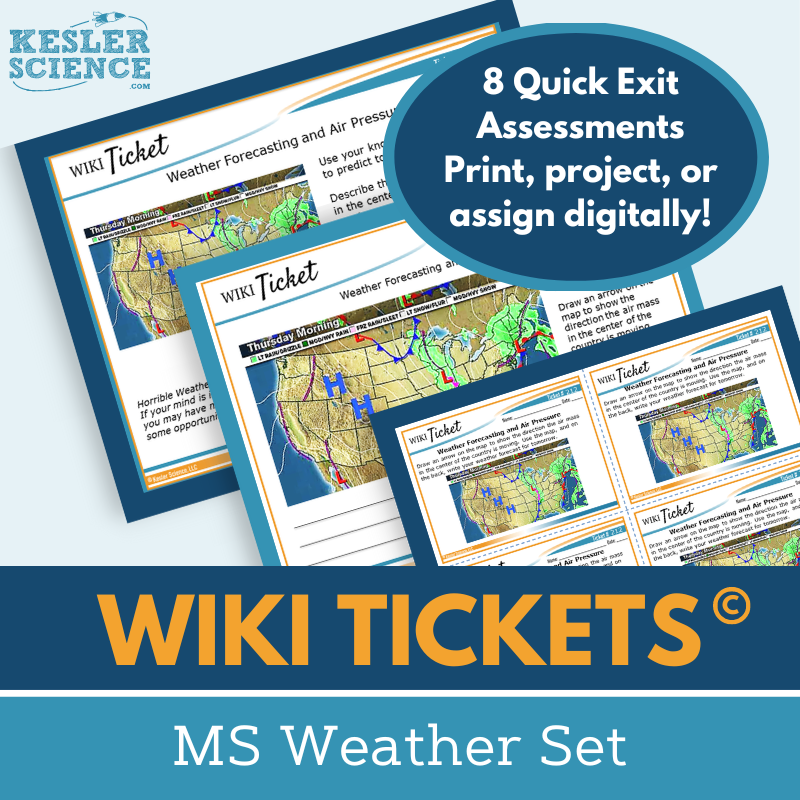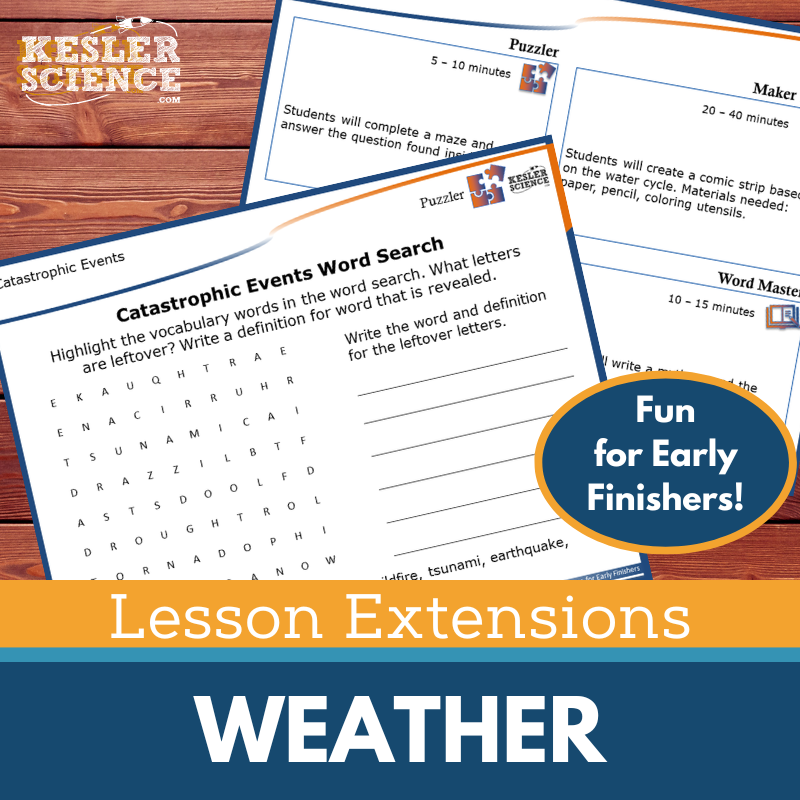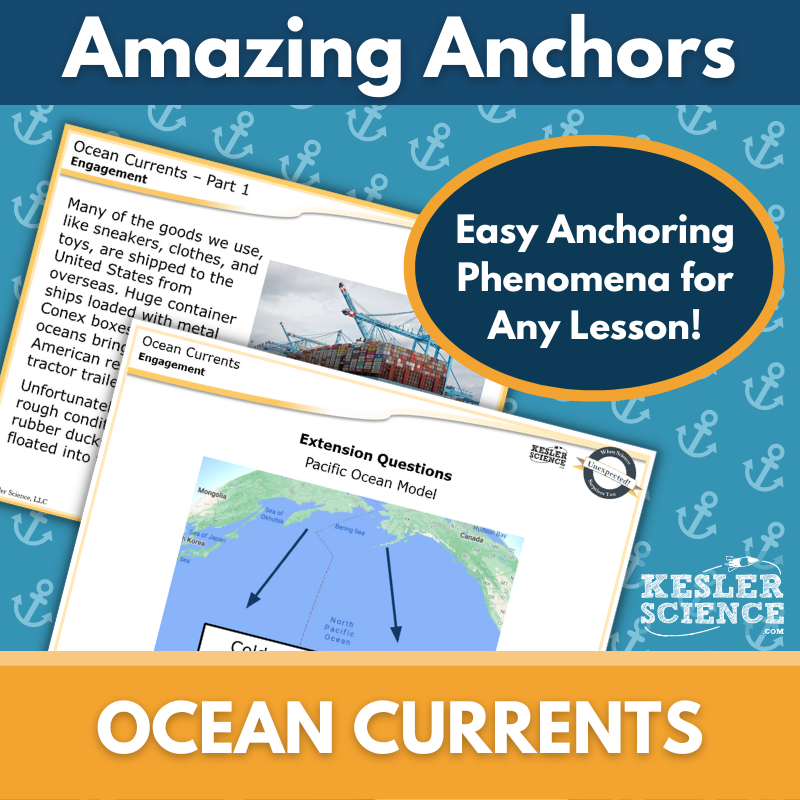Convection Currents Activities for Middle School Science
Kesler Science Convection Currents resources offer a comprehensive, student-centered approach to understanding how the Sun’s energy drives atmospheric and oceanic circulation. The resources below will give students a comprehensive understanding of convection currents. All of the following materials are also included in the Kesler Science Membership.
The Kesler Science Complete 5E Convection Currents lesson provides everything needed for an engaging, student-centered middle school unit. Students will explore how the Sun’s energy drives convection within the atmosphere and oceans, producing winds and currents. The lesson includes presentations, worksheets, choice projects, and assessments, all fully editable to fit your classroom needs. Differentiated, student-led activities allow for personalized learning while minimizing prep time for teachers.
The lesson follows the 5E model, with activities designed to engage, explore, explain, elaborate, and evaluate student understanding. Students begin by engaging with objectives and vocabulary, followed by a student-led exploration with differentiated station labs. These stations include hands-on activities, reading comprehension, research tasks, and videos. Output stations offer students various ways to demonstrate their knowledge, such as drawing, writing, and organizing information.
For evaluation, the lesson provides editable PowerPoints, interactive notebooks (in both English and Spanish), and assessment tools aligned with state standards. The resource is adaptable for in-person or virtual learning environments, with digital options available for the station labs and presentations. Extension activities are included for advanced learners, and the lesson’s structure ensures a dynamic, interactive learning experience.
The Kesler Science Complete 5E Convection Currents lesson provides everything needed for an engaging, student-centered middle school unit. Students will explore how the Sun’s energy drives convection within the atmosphere and oceans, producing winds and currents. The lesson includes presentations, worksheets, choice projects, and assessments, all fully editable to fit your classroom needs. Differentiated, student-led activities allow for personalized learning while minimizing prep time for teachers.
The lesson follows the 5E model, with activities designed to engage, explore, explain, elaborate, and evaluate student understanding. Students begin by engaging with objectives and vocabulary, followed by a student-led exploration with differentiated station labs. These stations include hands-on activities, reading comprehension, research tasks, and videos. Output stations offer students various ways to demonstrate their knowledge, such as drawing, writing, and organizing information.
For evaluation, the lesson provides editable PowerPoints, interactive notebooks (in both English and Spanish), and assessment tools aligned with state standards. The resource is adaptable for in-person or virtual learning environments, with digital options available for the station labs and presentations. Extension activities are included for advanced learners, and the lesson’s structure ensures a dynamic, interactive learning experience.
In the Kesler Science Convection Currents Station Lab, students take charge of their learning by rotating through nine stations, each designed to explore different aspects of convection. These stations cover input activities, like hands-on demonstrations, research tasks, reading comprehension, and videos, as well as output activities, such as drawing models, writing responses, and assessing their understanding. Students can work independently or in small groups, allowing for a personalized and student-led learning experience.
The lab is fully differentiated, with eight core stations plus a challenge station for early finishers. Each station is equipped with signage, literature, and task cards to guide students through the material. Stations like “Explore It!” offer hands-on learning, while others like “Research It!” and “Read It!” provide digital or paper-based activities. The “Write It!” and “Illustrate It!” stations help students organize and communicate their knowledge.
This modular lab is perfect for both in-person and virtual environments. The resources are adaptable, and many stations can be completed digitally using tools like PowerPoint or Google Slides. The teacher’s role is to facilitate learning, allowing students to direct their inquiry and explore convection currents in a dynamic, engaging way.
In the Kesler Science Convection Currents Station Lab, students take charge of their learning by rotating through nine stations, each designed to explore different aspects of convection. These stations cover input activities, like hands-on demonstrations, research tasks, reading comprehension, and videos, as well as output activities, such as drawing models, writing responses, and assessing their understanding. Students can work independently or in small groups, allowing for a personalized and student-led learning experience.
The lab is fully differentiated, with eight core stations plus a challenge station for early finishers. Each station is equipped with signage, literature, and task cards to guide students through the material. Stations like “Explore It!” offer hands-on learning, while others like “Research It!” and “Read It!” provide digital or paper-based activities. The “Write It!” and “Illustrate It!” stations help students organize and communicate their knowledge.
This modular lab is perfect for both in-person and virtual environments. The resources are adaptable, and many stations can be completed digitally using tools like PowerPoint or Google Slides. The teacher’s role is to facilitate learning, allowing students to direct their inquiry and explore convection currents in a dynamic, engaging way.
In the Kesler Science Convection Currents Student Choice Projects, middle school students choose from nine project options, plus a “design your own” project, to demonstrate their understanding of convection. The projects are designed to cater to different learning styles and allow students to take charge of their learning. A grading rubric is included for teacher, peer, or self-assessment.
The flexible and dynamic projects give students creative freedom while allowing teachers to modify the rubric to fit their grading needs. Whether it’s a presentation, model, or digital project, students can choose the method that best suits their skills and interests. The choice board offers diverse options to promote personalized learning.
The resource includes a Teacher Directions page for support and suggestions, plus differentiated options for students who need extra help or a challenge. The projects require basic classroom supplies such as paper, markers, and scissors, with some needing crafting supplies for model building. Many projects can also be completed digitally, making them adaptable for different learning environments.
In the Kesler Science Convection Currents Student Choice Projects, middle school students choose from nine project options, plus a “design your own” project, to demonstrate their understanding of convection. The projects are designed to cater to different learning styles and allow students to take charge of their learning. A grading rubric is included for teacher, peer, or self-assessment.
The flexible and dynamic projects give students creative freedom while allowing teachers to modify the rubric to fit their grading needs. Whether it’s a presentation, model, or digital project, students can choose the method that best suits their skills and interests. The choice board offers diverse options to promote personalized learning.
The resource includes a Teacher Directions page for support and suggestions, plus differentiated options for students who need extra help or a challenge. The projects require basic classroom supplies such as paper, markers, and scissors, with some needing crafting supplies for model building. Many projects can also be completed digitally, making them adaptable for different learning environments.
The Kesler Science Weather Interactive Notebook Bundle offers both print and digital versions to enhance student engagement while teaching key weather concepts. Perfect for traditional classrooms, 1:1 settings, or distance learning, this bundle covers important topics such as the atmosphere, catastrophic events, convection currents, hurricane formation, the water cycle, and weather maps.
Digital versions include a customizable PowerPoint file that can be uploaded to Google Slides or integrated into platforms like MS Teams, Schoology, and Canvas. It also features reflection pages, spaces for student notes, and a modified version for students with accommodations, all supported by a teacher answer key.
The paper version includes complete blank templates for the interactive notebook, pre-filled versions for students needing modifications or those who missed class, and color photos that demonstrate how each template is used, making it a versatile tool for teachers and students alike.
The Kesler Science Weather Interactive Notebook Bundle offers both print and digital versions to enhance student engagement while teaching key weather concepts. Perfect for traditional classrooms, 1:1 settings, or distance learning, this bundle covers important topics such as the atmosphere, catastrophic events, convection currents, hurricane formation, the water cycle, and weather maps.
Digital versions include a customizable PowerPoint file that can be uploaded to Google Slides or integrated into platforms like MS Teams, Schoology, and Canvas. It also features reflection pages, spaces for student notes, and a modified version for students with accommodations, all supported by a teacher answer key.
The paper version includes complete blank templates for the interactive notebook, pre-filled versions for students needing modifications or those who missed class, and color photos that demonstrate how each template is used, making it a versatile tool for teachers and students alike.
The Convection Currents Inquiry Lab aligns with NGSS MS-ESS2-6 and helps students explore how the Sun’s energy influences regional weather patterns. In this lab, students investigate how radiation heats solids and liquids at different rates and observe how warm air masses rise due to convection. The activity emphasizes developing models to understand how unequal heating and Earth’s rotation cause atmospheric and oceanic circulation patterns.
This lab offers both digital and print formats, with comprehension questions, Claim-Evidence-Reasoning (C.E.R.) prompts, and a reflection section included in each version. A pre-recorded demonstration video is available in the digital lab, allowing students to follow along even if they are absent or lack materials. Students use thermometers, beakers, sand, water, a heat lamp, and a US map to collect and analyze data during the hands-on version.
Each version includes three levels of differentiation—Dependent, Modified, and Independent—designed to support a wide range of learners. Teachers can edit all files in PowerPoint or Google Slides, and answer keys and planning guides are provided to streamline instruction. This flexible and engaging lab offers a complete experience for teaching how the Sun drives weather and climate patterns.
The Convection Currents Inquiry Lab aligns with NGSS MS-ESS2-6 and helps students explore how the Sun’s energy influences regional weather patterns. In this lab, students investigate how radiation heats solids and liquids at different rates and observe how warm air masses rise due to convection. The activity emphasizes developing models to understand how unequal heating and Earth’s rotation cause atmospheric and oceanic circulation patterns.
This lab offers both digital and print formats, with comprehension questions, Claim-Evidence-Reasoning (C.E.R.) prompts, and a reflection section included in each version. A pre-recorded demonstration video is available in the digital lab, allowing students to follow along even if they are absent or lack materials. Students use thermometers, beakers, sand, water, a heat lamp, and a US map to collect and analyze data during the hands-on version.
Each version includes three levels of differentiation—Dependent, Modified, and Independent—designed to support a wide range of learners. Teachers can edit all files in PowerPoint or Google Slides, and answer keys and planning guides are provided to streamline instruction. This flexible and engaging lab offers a complete experience for teaching how the Sun drives weather and climate patterns.
In the Kesler Science Convection Currents Reading Comprehension activity, students explore convection currents by reading a nonfiction article explaining how the Sun's energy drives convection in the atmosphere and oceans, creating winds. After reading, students complete comprehension questions and build a convection current using household items.
The science reading comprehension activities are designed to engage middle school students with an interesting article, questions, and a mini-project. The leveled articles increase reading comprehension and science literacy, with Lexile levels ranging from 1100-1300.
The resource includes a hands-on mini-project, 5-7 comprehension questions, and Cornell notes templates. It’s perfect for classroom or virtual learning and can be used in Google Classroom, MS Teams, Schoology, or Canvas. This resource helps build students' science literacy, textual analysis, and reading comprehension skills.
In the Kesler Science Convection Currents Reading Comprehension activity, students explore convection currents by reading a nonfiction article explaining how the Sun's energy drives convection in the atmosphere and oceans, creating winds. After reading, students complete comprehension questions and build a convection current using household items.
The science reading comprehension activities are designed to engage middle school students with an interesting article, questions, and a mini-project. The leveled articles increase reading comprehension and science literacy, with Lexile levels ranging from 1100-1300.
The resource includes a hands-on mini-project, 5-7 comprehension questions, and Cornell notes templates. It’s perfect for classroom or virtual learning and can be used in Google Classroom, MS Teams, Schoology, or Canvas. This resource helps build students' science literacy, textual analysis, and reading comprehension skills.
The Convection Science Writing Prompt engages middle school students in a creative skit or drama-based activity that reinforces their understanding of convection in earth science. This print-or-digital exercise encourages science reasoning and writing skills, while also being suitable for both in-person and virtual learning environments. Designed for students with prior knowledge or access to research materials, this low-prep activity supports elaboration and exploration of key science concepts.
The resource is aligned with TEKS or NGSS standards and is available as part of a larger collection of writing prompts. It includes teacher directions with answer guides and rubrics, as well as multiple student handout formats—full-sized and half-sheet—for flexible use in interactive notebooks or writing journals. A digital PowerPoint version, compatible with Google Slides, ensures accessibility for remote learners and ease of classroom use.
This convection writing prompt can be used in a variety of ways, including as a cross-curricular project, pre-test assessment, enrichment task, student choice activity, or differentiation tool. Its versatility makes it ideal for early finishers, extra credit opportunities, make-up work, or TELPAS samples, and the final student work can be displayed or compiled into a class anthology.
The Convection Science Writing Prompt engages middle school students in a creative skit or drama-based activity that reinforces their understanding of convection in earth science. This print-or-digital exercise encourages science reasoning and writing skills, while also being suitable for both in-person and virtual learning environments. Designed for students with prior knowledge or access to research materials, this low-prep activity supports elaboration and exploration of key science concepts.
The resource is aligned with TEKS or NGSS standards and is available as part of a larger collection of writing prompts. It includes teacher directions with answer guides and rubrics, as well as multiple student handout formats—full-sized and half-sheet—for flexible use in interactive notebooks or writing journals. A digital PowerPoint version, compatible with Google Slides, ensures accessibility for remote learners and ease of classroom use.
This convection writing prompt can be used in a variety of ways, including as a cross-curricular project, pre-test assessment, enrichment task, student choice activity, or differentiation tool. Its versatility makes it ideal for early finishers, extra credit opportunities, make-up work, or TELPAS samples, and the final student work can be displayed or compiled into a class anthology.
The Kesler Science Weather WIKI Tickets are engaging formative assessments designed for 6th-8th grade science topics, offering flexible options for checking student understanding. The Weather Set includes eight WIKI Tickets, each aligned to NGSS and TEKS standards, with five format choices: a projection version, three handout sizes (full, split, and quarter-page), and a digital version (editable PPT or Google Slides). These assessments provide a fun, interactive way to gauge student learning.
The WIKI Tickets can be used as exit tickets, bellringers, or during lessons to quickly assess students' grasp of concepts such as the water cycle, weather maps, and ocean currents. Each ticket helps reinforce key topics, ensuring that students are meeting learning goals in a creative, low-pressure way. A bonus table of contents file is included for easy reference to ensure standards alignment.
Perfect for both in-person and virtual learning, these assessments allow for seamless integration into various classroom settings. Whether projected in class or completed digitally, WIKI Tickets help educators gauge student progress and adapt instruction to meet their needs.
The Kesler Science Weather WIKI Tickets are engaging formative assessments designed for 6th-8th grade science topics, offering flexible options for checking student understanding. The Weather Set includes eight WIKI Tickets, each aligned to NGSS and TEKS standards, with five format choices: a projection version, three handout sizes (full, split, and quarter-page), and a digital version (editable PPT or Google Slides). These assessments provide a fun, interactive way to gauge student learning.
The WIKI Tickets can be used as exit tickets, bellringers, or during lessons to quickly assess students' grasp of concepts such as the water cycle, weather maps, and ocean currents. Each ticket helps reinforce key topics, ensuring that students are meeting learning goals in a creative, low-pressure way. A bonus table of contents file is included for easy reference to ensure standards alignment.
Perfect for both in-person and virtual learning, these assessments allow for seamless integration into various classroom settings. Whether projected in class or completed digitally, WIKI Tickets help educators gauge student progress and adapt instruction to meet their needs.
The Kesler Science Lesson Extensions provide engaging, rigorous activities designed to challenge fast finishers and deepen student understanding. These extensions offer a variety of options, including puzzles, hands-on maker space activities, tech connections, and creative writing, all linked to the weather standards of NGSS and TEKS. Whether you're looking to end a lesson or fill gaps during testing, these activities keep students actively learning while promoting critical thinking.
Each extension includes teacher directions, answer keys, and printable or digital versions for easy classroom integration. The diverse formats allow students to work individually or collaborate, fostering creativity and independent learning. The resources are ideal for pushing students who are ready for more advanced learning, encouraging them to explore topics like catastrophic events, hurricane formation, and the water cycle.
Perfect for use with any of the Kesler Science weather lessons, these extensions help reinforce key concepts while offering a fun and meaningful challenge. With options for both digital and paper use, they are a flexible way to scaffold learning and support students’ growth.
The Kesler Science Lesson Extensions provide engaging, rigorous activities designed to challenge fast finishers and deepen student understanding. These extensions offer a variety of options, including puzzles, hands-on maker space activities, tech connections, and creative writing, all linked to the weather standards of NGSS and TEKS. Whether you're looking to end a lesson or fill gaps during testing, these activities keep students actively learning while promoting critical thinking.
Each extension includes teacher directions, answer keys, and printable or digital versions for easy classroom integration. The diverse formats allow students to work individually or collaborate, fostering creativity and independent learning. The resources are ideal for pushing students who are ready for more advanced learning, encouraging them to explore topics like catastrophic events, hurricane formation, and the water cycle.
Perfect for use with any of the Kesler Science weather lessons, these extensions help reinforce key concepts while offering a fun and meaningful challenge. With options for both digital and paper use, they are a flexible way to scaffold learning and support students’ growth.
This Amazing Anchors Phenomenon Lesson introduces and reinforces the concept of ocean currents through a real-world event involving a Conex box spill. Students begin with an engaging reading that explores how materials travel across the ocean, followed by comprehension and extension questions to spark curiosity and set the stage for deeper learning. A second explanatory reading helps students understand the science behind ocean currents, with follow-up questions to reinforce and apply key concepts.
The resource includes teacher directions, answer keys, and editable materials in both print and digital formats, making it easy to integrate into any classroom. Full-page projection slides, printable handouts, and LMS-ready PowerPoints are all provided. Differentiated versions support diverse learners, including a modified reading with simplified language and sentence starters.
Aligned with NGSS ESS2-6 and TEKS standards, this no-prep activity is perfect for the Engagement and Elaboration phases of the 5E instructional model. Whether used in-person or online, the before-and-after readings are an effective way to bookend a main lesson and help students connect science content to the real world.
This Amazing Anchors Phenomenon Lesson introduces and reinforces the concept of ocean currents through a real-world event involving a Conex box spill. Students begin with an engaging reading that explores how materials travel across the ocean, followed by comprehension and extension questions to spark curiosity and set the stage for deeper learning. A second explanatory reading helps students understand the science behind ocean currents, with follow-up questions to reinforce and apply key concepts.
The resource includes teacher directions, answer keys, and editable materials in both print and digital formats, making it easy to integrate into any classroom. Full-page projection slides, printable handouts, and LMS-ready PowerPoints are all provided. Differentiated versions support diverse learners, including a modified reading with simplified language and sentence starters.
Aligned with NGSS ESS2-6 and TEKS standards, this no-prep activity is perfect for the Engagement and Elaboration phases of the 5E instructional model. Whether used in-person or online, the before-and-after readings are an effective way to bookend a main lesson and help students connect science content to the real world.
Year-Round Resources
These year-round activities will increase your students' understanding of many middle school science topics. All of these activities are also included in the Kesler Science Membership.
Visual Data & Graphing
You're not alone if your students struggle with understanding graphs, charts, and tables. It's a skill that takes an enormous amount of practice. This resource will help students build a strong foundation in analyzing data and creating their own data visualizations.
Bell Ringers and Warm-Ups
These middle school science bell ringers are an excellent way to engage your students as soon as they walk into your classroom. This comprehensive FULL YEAR resource includes everything you need to start off each science class with an interesting warm-up activity.
Review Board Games
Each game board has been carefully designed to keep students engaged. There are 10 different action spaces on each board and dozens of question cards. All of the actions are related to science concepts and keep the students motivated throughout the game.
Each game is ready to play. Simply print out the board and the cards and let the students enjoy reviewing nine different units.
Essential Questions
Below are the essential questions associated with the lessons and activities included in this unit. This topic is only one of more than 100 middle school science topics included in the Kesler Science Membership.
-
How does the Sun’s energy drive convection within the atmosphere and oceans, producing winds and ocean currents?
Kesler Science Membership
Imagine never having to search for another middle school science lesson again. The membership gives you access to ALL of the Kesler Science products in one place (Yes, including everything above).
Say goodbye to long hours of lesson prep.

